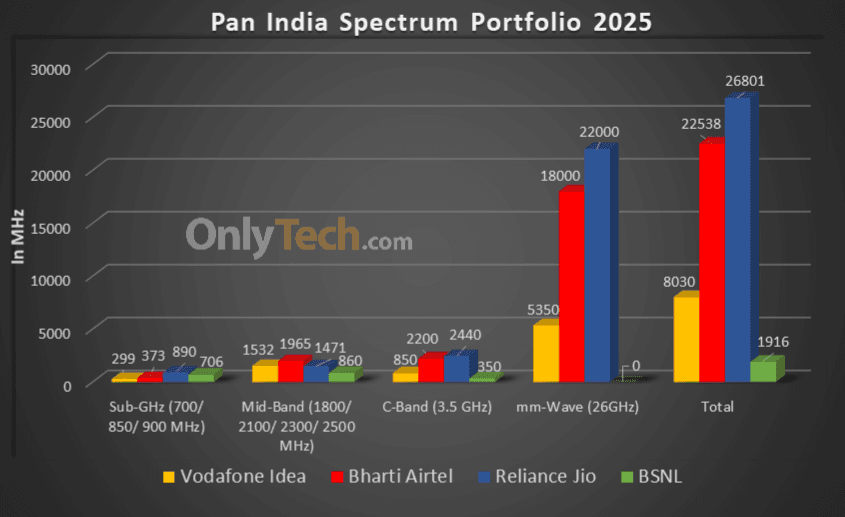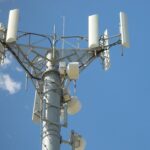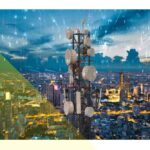Spectrum is for telecommunication what jet fuel is for aviation. Spectrum is a range of electromagnetic frequencies or airwaves that telecom companies use for establishing a connection between a cell tower and a mobile phone. The bandwidth of this spectrum is directly proportional to the speed of a wireless data network (since more data can be transmitted simultaneously through a broader data pipeline). In contrast, the frequency is inversely proportional to the coverage (since lower frequencies penetrate better through physical barriers and thus have wider coverage).
The spectrum holding data sheet embedded in this article represents the current spectrum holdings of all active telecom operators across all frequency bands across all 22 telecom circles along with their liberalisation status and expiry dates. All figures represented are in MHz. The value mentioned in the bracket beside the frequency at the base of each sheet is the band number where ‘B’ stands for 4G LTE band whereas ‘n’ stands for the corresponding 5G NR band.
The spectrum shown under BSNL and Aircel in white is reserved for the respective operators but has not yet been officially allotted to them.
Spectrum Liberalisation:
Spectrum was administratively allocated to operators in each of the 22 licensed service areas or circles prior to 2010, this spectrum is called non-liberalised and can only be used for 2G services whereas all airwaves allotted post-2010 have been through a Spectrum Auction where operators have paid the market discovered price and this spectrum is called liberalised and can be used for any technology platform 2G/3G/4G/5G. Alternatively, operators may choose to liberalise their administratively allotted spectrum by paying the market-discovered price to DoT on a pro-rata basis for the remaining validity of the spectrum.
Paired and Unpaired spectrum:
Spectrum may be paired or unpaired, bands 1/3/5/8/28 are all paired where one set of frequencies is used for uplink whereas another distinct set of frequencies is used for downlink known as Frequency-division duplexing (FDD), whereas bands 40/41/78/258 are unpaired where both uplink and downlink happens in the same set of frequencies separated by the time of uplink and downlink known as Time-division duplexing (TDD).
List of Indian FDD Bands:
| 4G LTE band | 5G NR band | Uplink frequency range (MHz) | Downlink frequency range (MHz) | Bandwidth for telecom (MHz) | Block size (MHz) |
|---|---|---|---|---|---|
| B1 | n1 | 1939-1979 | 2129-2169 | 40×2 | 5×2 |
| B3 | n3 | 1710-1780 | 1805-1875 | 70×2 | 0.2×2 |
| B5 | n5 | 824-844 | 869-889 | 20×2 | 1.25×2 |
| B8 | n8 | 890-915 | 935-960 | 25×2 | 0.2×2 |
| B28 | n28 | 723-733/ 738-748 | 778-788/ 793-803 | 20×2 | 5×2 |
List of Indian TDD Bands:
| 4G LTE band | 5G NR band | Frequency range (MHz) | Bandwidth for telecom (MHz) | Block size (MHz) |
|---|---|---|---|---|
| B40 | n40 | 2300-2380 | 80 | 10 |
| B41 | n41 | 2535-2555/ 2615-2655 | 60 | 10 |
| – | n78 | 3300-3670 | 370 | 10 |
| – | n258 | 24250-27500 | 3250 | 50 |
Spectrum caps:
A spectrum cap dictates how much spectrum a particular operator can hold in a circle for a specific band. There is a 40% cap for Sub-GHz spectrum in the 700/850/900 MHz bands combined, a 40% cap for Mid-Band spectrum in the 1800/2100/2300/2500 MHz bands combined, a 40% cap for the C-Band spectrum of 3300-3670 MHz and a 40% cap for the mm-Wave spectrum bands of 24.25-27.5 GHz. The current spectrum caps are denoted in the spectrum chart.
Overall spectrum holdings of operators (in MHz):
| Operator/Holding | Jio | Airtel | Vi | BSNL |
|---|---|---|---|---|
| Sub-GHz | 890 | 373.2 | 298.8 | 706 |
| Mid Band | 1470.8 | 1964.9 | 1531.6 | 860 |
| C-Band | 2440 | 2200 | 850 | 350 |
| mm-Wave Band | 22000 | 18000 | 5350 | 0 |
| Total | 26,800.8 | 22,538.1 | 8,030.4 | 1,916 |
Spectrum sharing/trading/leasing guidelines:
- Telecom operators holding CMTS/UASL/UL licenses can enter into a Spectrum-Sharing agreement with each other so long as both parties hold liberalised spectrum in the same band in the same circle. Spectrum sharing is possible only on a Pan LSA level in block sizes defined by DoT and only after one year of an operator acquiring the spectrum.
- Telecom operators holding CMTS/UASL/UL licenses can enter into a Spectrum-Trading agreement with each other so long as the spectrum being sold is liberalised. Trading of spectrum is possible only on a Pan LSA level in block sizes defined by DoT and only after two years of an operator acquiring the spectrum.
- Telecom operators may enter into a Spectrum-Leasing agreement only with Enterprises holding a Captive Non-Public Network (CNPN) license and not with each other. The lease may be limited to any geographic area within the LSA and for any duration mutually agreed upon by both parties. A CNPN licensee can lease spectrum from multiple operators within an LSA.
Note: We update this chart in real-time to ensure it is always up to date with the latest changes in spectrum holding. Certain human errors might have crept in during the manual compilation of the data, any mistakes/ rectification can be brought to the Team’s notice through the comments section below.








What jio didi with the additional 10 MHz spectrum purchased in B3
@Esmail Bro: Good question. Please reply.
Jio will use it for 4G only. No other use for it.
@Esmail But Bro as far as I know harmonization activity was completed for Band 3 before auctions. Then why Jio is taking too much time to deploy 20 mhz of Band 3 LTE ?
Panditji might have asked Ambani to add it on the day of shubh mahurat 😂
@Esmail bro: OnePlus India says that OnePlus 10T supports only n28a and not n28b 5G Band. Now Jio acquired spectrum in the range of 723 mhz – 733 mhz (uplink) and 778 mhz – 788 mhz (downlink) which falls under both n28a and n28b. Now my question to you is will OnePlus 10T connect to Jio n28 5G Band since the spectrum acquired by Jio in the n28 band falls under both n28a and n28b (Also consider the fact that India is following n28b frequency band) ?
Like you said India follows n28B for 700 MHz which is Uplink: 718-748 Downlink: 773-803 and Jio has won spectrum which is allotted as Uplink: 723-733 Downlink: 778-788 which is completely within n28B only, I don’t know from where you got n28A in Jio’s allotment. Also if your phone specifies that it only supports n28A then you won’t be able to use Jio’s 700 MHz spectrum on it.
@Esmail Bro: Bro please refer (r-spectrum.com.au/resources/mobile-technology/4g/4g-frequency-bands/b28-700-mhz) wherein it is mentioned that B28A (uplink – 703 to 733 MHz and downlink – 758 to 788 MHz) and B28B (uplink – 718 to 748 MHz and downlink – 773-803 MHz) which implies that Jio’s spectrum in N28 band falls under both n28a and n28b.
@Esmail Bro: Please refer (www.aliexpress.com/item/32890517317.html) This repeater also says N28A (703-733MHz – Uplink and 758-788MHz – Downlink).
If this frequency range of n28A is correct then Jio’s allotted spectrum lies in the common overlap of n28A and n28B in which case it will be supported by phones with support for either of the 2 bands. So in short Jio 700 MHz will be supported by both n28A and n28B phones.
@Esmail Bro: So can I conclude that OnePlus 10T which supports only n28a will support Jio’s 700mhz 5G spectrum ?
Yes it would be safe to assume that. There is a total 15 MHz overlap between the two portions of n28 but out of that 5 MHz has been given to the RRTS and metro rail services so only 10 MHz remained which Jio cleverly picked up. Now any further 700 MHz bought by any operator would be from the 15 MHz that remained unsold and belongs exclusively in the n28B region. The defence forces and Indian railways have been allotted spectrum which is exclusively in n28A.